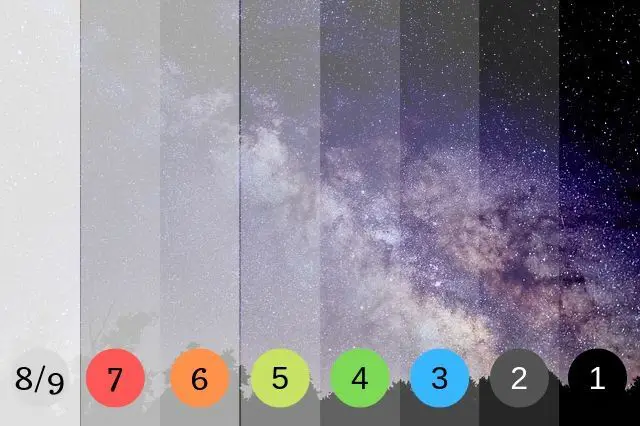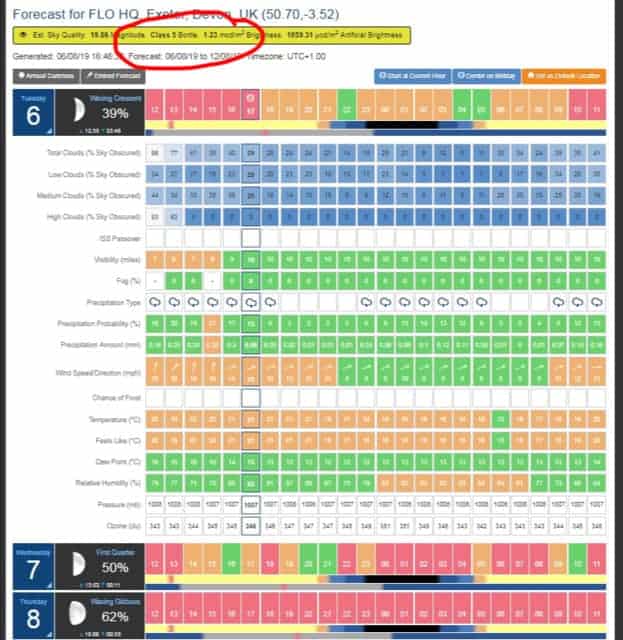Learn how to determine the levels of the darkness of the night sky to get the best viewing experience
To know how dark the sky above you is; the Bortle’s scale of darkness can be used. It ranges from 1 to 9, nine being the worst telescope viewing, and one being the best.
The darkness of the sky is a huge factor in your astronomical quest. The darker the night sky, the more you can see. A faint target object, like the M9 Globular Cluster, may not be seen if the sky is not dark enough.
Many variables affect darkness, such as light pollution, smog, humidity, and elevation of your site. Today, you will learn some methods to know the sky’s darkness and Bortle’s Nine Scale of the Sky’s Darkness.
What is the Significance of Gauging How Dark it is?
Determining how dark the sky is in your general observation area is essential because it affects how well your astronomical observation will be. Likewise, the moment you learn how dark it is, you can figure out if your target objects will be visible or not.
Different sites have varying levels of darkness. This level can also change in every season, which is influenced by other variables. Again, with this knowledge, you can plot several site options for varying times of the year.
Factors Affecting Transparency of the Sky
The transparency of the sky is influenced by many variables, which include smog, light pollution, site elevation, and humidity. Consequently, it is very challenging to look for a good site for observing celestial bodies.
In astronomy, transparency refers to the sky’s opacity, which decreases as humidity and smog concentration increases in the atmosphere. Moreover, a less transparent sky is worsened by light pollution because it washes out the faintest star in the sky. I often compare this to driving with the car’s dome light on at night. It is harder to see out through the windows when it is on.
Meanwhile, at higher altitudes, the sky’s transparency increases because there is a thinner layer of atmosphere. This observation climate is the ultimate reason why observatories are situated at elevated ground levels or in space.
In line with the previous, you can tell how much air is in your line of sight by the angle of elevation with the horizon. For any observer, the amount of air overhead is referred to as 1 air mass. The amount of air 30 degrees above the horizon is called 2 air masses, while for 10 degrees; it is called 5.6 air masses. Finally, the amount of air on the horizon is 40 air masses.
Methods of Measuring Sky’s Darkness
There are specific ways established in measuring the sky’s darkness. These methods include naked-eye limiting magnitude (NELM), use of constellations with stable brightness over the year, and Bortle’s nine dark-scale. The latter approach comprehensively incorporates the NELM and observations seen through the telescope as a standard basis for the creation of Bortle’s 9 Dark-Scale.
Naked-Eye Limiting Magnitude (NELM)
This method uses the faintest star visible to the naked eye of the observer as a precise estimate of the sky’s darkness. However, there have been several discrepancies with this method due to the vast dependencies of the observer’s eyesight. It does not provide an objective and standard magnitude of the sky. So it is relative to each observer individually.
What Stars Have Stable Brightness Through the Year
In line with NELM, astronomers use stars with stable brightness through the year as their point of reference. These stars must also be visible in all parts of the globe to be a good standard and avoid biases.
Ursa Minor and celestial poles are a common reference which is visible to observers in the middle latitude. However, to strike a balance for the people in the Southern Hemisphere, three stars can be used as a reference – Ursa Minor, Great Square Pegasus, and Octans.
Bortle Dark-Sky Scale
This method formulated by Bortle incorporates many variables such as NELM, magnitude limit of a telescope, zodiacal light, visibility of Triangulum Galaxy (M33) and Andromeda Galaxy (M31) in an observer’s naked eye, and the Milky Way.
Bortle Nine Dark-Sky Scale
John E. Bortle formulated the nine scales on the sky’s darkness at a specific area. This numeric scale gauges the sky’s darkness by evaluating the visibility of individual objects with the presence of sky glow and light pollution. Scale 1 is the darkest sky on Earth, while Scale 9 is the sky’s darkness in urban cities.
The celestial objects used in this method are the following.
M31 – Andromeda Galaxy
M33 – Triangulum Galaxy
M4 – globular cluster in Scorpius
M5 – globular cluster in Serpens
M15 – a globular cluster in Pegasus
M22 – a globular cluster in Sagittarius
Airglow – faint natural glow in the night sky which as seen at 15-degrees above the horizon
Class 1 – Excellent Dark-Sky
Conditions to be met
- All seven major stars of Ursa Minor are visible
- Milky Way can be seen overhead
- The Zodiacal lights are visible in spring and autumn nights
- Using peripheral vision, you can partially see the Triangulum Galaxy at night
- High visibility of M5, M15, M4, or M22
- Triangulum Galaxy can immediately be spotted, and details of the Milky Way Galaxy as well
- Scorpius and Sagitarrius cast a shadow
For Class 1 or the excellent dark-sky site, the naked-eye limiting magnitude is between 7.6 – 8.0. And the view of Venus or Jupiter seems to fade away in the dark sky. In terms of airglow, it is readily visible. Stars with magnitude17.5 can be seen using a 12.5-inch telescope with effort. Likewise, you can observe up to 19th magnitude stars using a 20-inch scope.
Class 2 – Dark Sky
All conditions are satisfied in Class 1 except for the shadows of Scorpius and Sagittarius. The NELM of Class 2 is between 7.1 to 7.5. You can observe stars with a magnitude of 16 or 17 using a 32-cm telescope.
Class 3 – Rural Sky
All conditions of Class 1 are met except – observability of the Triangulum Galaxy and details of Milky Way Galaxy, and the shadows of Scorpius and Sagittarius. The NELM for Class 3 is 6.6 to 7.0. You can see stars up to the 16th magnitude using a 32-cm telescope.
Class 4 – Suburban / Rural Transition
All conditions of Class 1 are met except
- The clear appearance of M15, M22, M4, or M5
- Clear visibility of the Triangulum Galaxy and Milky Way Galaxy
- The presence of the shadows of Scorpius and Sagittarius
The NELM for Class 4 is between 6.1 to 6.5, and you can view stars up to 15.5 magnitudes using a 32-cm telescope.
Class 5 – Suburban Sky
All conditions of Class 1 are present except
- Partial visibility of Triangulum Galaxy using peripheral vision
- Clear sight for any of the following – M22, M4, M5 or M15
- A clear vision for the details of the M33 and Milky Way Galaxy
- The appearance of the shadows of Scorpius and Sagittarius
It has a NELM between 5.6 to 6.0, and you can view stars with magnitude 14.5 to 15 using a 32-cm telescope.
Class 6 – Bright Suburban Sky
Conditions to be met are the following
- Visibility of all the seven major stars of Ursa Minor
- Milky Way can is visible overhead
- Zodiacal lights cannot be seen in the nights of spring and autumn
It has a NELM of 5.0 and using a 32-cm telescope; you can view stars with a magnitude of 14.
Class 7 – City / Suburban Transition
Conditions to be met includes
- Visibility of all the seven major stars of Ursa Minor
- Milky Way cannot be seen overhead
It has a NELM of 5.0, and you can see stars with magnitude 14 using a 32-cm telescope.
Class 8 – City Sky
Conditions to be met includes
- Not all the seven major stars of Ursa Minor can be seen
- The partial sight of Andromeda Galaxy
Class 8 has a NELM of 4.5 with the best effort. In terms of airglow, you would see orange-like or white gray-like faint light glows. Using a 32-cm telescope, you can view stars with a magnitude of 13.
Class 9 – Inner City Sky
Conditions to be met includes
- Not all the seven major stars of Ursa Minor can be seen
- Andromeda Galaxy cannot be seen
- Its limiting magnitude is 4.0 or lower, and no Messier targets can be seen in the night sky.
Tools to Find a Good Dark Sky Site
With all the variables mentioned, it is very challenging to find a good spot for an excellent dark sky for observational astronomy. However, with modern innovations and technology, we have available sites and software to help us out in finding a good spot for viewing these celestial bodies.
You can visit and use International Dark Sky Places and CIRES Colorado’s New World Atlas of Artificial Sky Brightness in gauging which areas has an excellent dark sky for astronomy. Both tools illustrate a map showing areas in the United States with good to magnificent dark skies for astronomy. You can zoom in and out of the map to have a good grip of the location.
Also, here is a cool weather/ dark sky app for your computer, or cell phone. So far it is free and pretty awesome to get a simple go no go weather and visibility report and your location on the Bortle scale. ClearOutside.com is the site, check it out here.
Many amateur and professional astronomers find these tools a great help in looking for a great spot with enough dark sky. It eases the burden of manually searching and going to the sites in real-time, later realizing it does not have enough darkness for astronomical viewing.
Need More?
Hopefully you enjoyed this article regarding the importance of the sky’s darkness and how to gauge it.
If you found this article useful, These articles should assist you as well.



